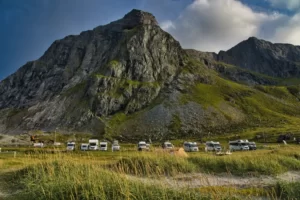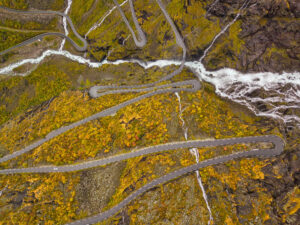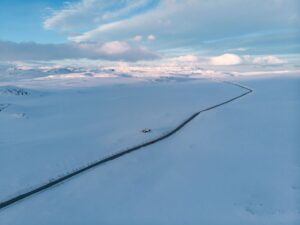#11 Go Fishing
Although most people plan their vacation to Norway for the summer, if you want the biggest fish, you should visit Norway in the winter. Head to Northern Norway, specifically to the stunning Lofoten Islands, between January and April to take part in the famous cod (skrei) fishing.
Skrei comes to Lofoten from the Barents Sea to spawn, and this annual migration is a natural wonder that helped to build Norway as a nation. The stockfish trade played a significant role in the Norwegian economy for centuries, and it was the country’s most important export item since the Viking times until the discovery of oil in the North Sea in the late 1960s.
Lofoten is also known for hosting the world championship in Skrei fishing, where fishers from around the world gather to compete. The championship takes place in March, and participants must use traditional fishing methods, such as hand lines, to catch as many fish as possible. The event attracts a large crowd, and it is a great opportunity to experience the culture and traditions of the area while enjoying some world-class fishing.
Have we Done it?
Yes! We went fishing with Go2Lofoten in Svolvær at the beginning of April 2023, and it was an amazing trip. It was a beautiful sunny day with lots of snow on the mountains and a calm sea. The captain was friendly, funny, and knowledgeable, and it felt like a fishing trip combined with sightseeing. We learned a lot about fishing and the lives of fishermen in Lofoten, and when Radka caught a nice cod, it was the cherry on top of the cake.
#12 Explore Ice Caves
In Norway, ice cave exploration is most commonly done in the region of Svalbard. Here, you can take guided tours to explore blue ice caves that have formed within glaciers. These caves are often accessed by snowmobile or dog sled, adding to the adventure of the experience. If you get lucky, you might even spot polar bears!
Visiting Svalbard in winter can be a truly unique and adventurous experience since Svalbard is one of the closest locations to the North Pole that is accessible to tourists. Svalbard is located in the Arctic Ocean, and in winter, the island is transformed into a frozen wonderland with snow and ice covering the landscape.
One of the main attractions in Svalbard during winter is the Northern Lights, which can often be seen dancing in the sky on clear nights. Another popular activity is dog sledding, where you can mush your own team of huskies through the snow-covered terrain.
Have we Visited Ice Caves in Norway?
Yes! The ice cave at Larsbreen Glacier was a frequent goal of our trips when I lived on Svalbard. That cave was special because you had to climb a rope ladder to get down, and then you found yourself in a labyrinth of small corridors under the glacier.
In 2017 we went with Ivar to Iceland, where we visited an ice cave and were so disappointed. Even though we bought a “small group experience,” all tour operators entered the same cave. We just took a peek inside and turned around as it was filled with people, and felt very claustrophobic despite the relatively big size of the cave.
The cave on Svalbard was a completely different story, and I wish to come back to Svalbard in winter and see it again or even explore some more caves further away from Longyearbyen.
#13 Go Sledding
Sledding is a fun and exciting winter activity requiring no special skills or expensive equipment. In Norway, there are many great places to try tobogganing, and it’s a great alternative to skiing for those who want to enjoy the winter landscape. The activity involves sliding down a slope on a sled, often at high speeds, which can be an exhilarating experience. It’s also a great activity for families and groups of friends to enjoy together.
One of Norway’s best places to go tobogganing is in Lillehammer, which hosted the 1994 Winter Olympics. The Toboggan Run in Olympiaparken is a popular attraction in the area and offers a thrilling ride down a 1,000-meter-long track. The run is suitable for all ages and is open throughout winter, usually from December to April.
Some other popular locations to enjoy sledding are Dagali Fjellpark and Skarslia Ski Resort, near Geilo, or the ski resorts in Beitostlølen and Hemsedal.
If you are visiting Oslo in winter, and there is enough snow, you should add Korketrekken to your bucket list! Korketrekken is a famous toboggan run in Oslo, and it is a popular destination for locals and tourists alike. The run starts at Frognerseteren, a popular recreational area and metro stop in Oslo, and winds down a steep hill for 2 kilometers, ending at Midtstuen metro station. The track is open to anyone with a sled, and there is no entrance fee. Sleds can be rented at Frognerseteren or brought from home.
Have we Tried Tobogganing in Norway?
Yes! In winter 2021, I worked for Dagali Fjellpark, where you can rent sleds and enjoy their toboggan run. It was so much fun, and I loved it way more than skiing.
You hook the sled on the T-lift that pulls you up the hill. There are separate ski pistes for skiing and sledding, so you do not have to be afraid that you will crash into someone. And then you just enjoy sledding down a nearly 2 km long prepared track that ends at the lower station of the ski lift, where you hook the sled to the T-lift again and continue having fun!
#14 Take a Train Ride Through Winter Landscape
Taking a train ride through Norway’s winter landscape can be an unforgettable experience that offers stunning views and a unique perspective of the country’s winter wonderland. While driving can also be a good option, train travel allows you to relax and enjoy the scenery without worrying about road conditions. Plus, you can also access areas that may not be reachable by car.
If you’re seeking an authentic and natural experience in Norway, winter is the perfect time to visit the Flåm area and do Norway in a Nutshell tour.
Norway in a Nutshell is a popular tour package that typically includes a combination of train, bus, and boat rides, as well as a visit to some of the most iconic attractions in the country, such as the Flåm Railway and the UNESCO-listed fjords Aurlandsfjord and Nærøyfjord. The tour is popular among tourists because it offers a convenient way to explore multiple destinations quickly, all while taking in the breathtaking scenery that Norway is known for. Despite the popular attraction of the Norwegian fjords, the wintertime offers a sense of tranquility and solitude as the crowds dissipate.
You can plan to make Norway in a Nutshell trip into several days of winter adventures, stopping in Geilo, Flåm, Voss, and Bergen.
Geilo is a popular winter destination in Norway, known for its excellent skiing opportunities and winter activities. Geilo belongs to one of the biggest ski centers in the country, catering to all levels of skiing and snowboarding abilities. There are ski schools, rentals, and guided tours available. If skiing is not your thing, you can try dog sledding, horseback riding, driving a snowmobile, or sledding in the nearby Skarslia or Dagali Fjellpark.
Voss is home to two of the biggest ski resorts in Fjord Norway – Voss Resort and Myrkdalen, offering a combined 70 kilometers of slopes for skiers of all levels. With 20 ski lifts, there is plenty of terrain to explore, including exciting off-piste areas and dedicated skiing areas for children. If skiing is not your thing, you can still soak in the breathtaking winter scenery by embarking on a guided snowshoe hike or a dog sledding adventure!
Have we Done it?
No. We have a car, so we usually go for a road trip since it is often cheaper than train tickets. However, not everyone is comfortable driving on ice and snow, and I think exploring Norway in winter by train is great! The areas covered by Norway in a Nutshell experience are pretty all year round, but if I had to choose, I would go in winter to avoid the crowds.
#15 Celebrate Christmas and New Year’s Eve
A few options may interest you if you’re looking for a snowy New Year’s Eve celebration in Norway.
🎡 Christmas Holidays in Tromsø
One option is to head to Tromsø, known as the “Gateway to the Arctic” and a popular destination for viewing the Northern Lights. Tromsø is located in northern Norway, so there’s a good chance you’ll have a white, snowy New Year’s Eve here. You can join in on the local celebrations, which usually include fireworks and concerts, and there are plenty of opportunities for winter activities like dog sledding or visiting a reindeer farm.
🎄 Christmas and New Year’s Eve in Lillehammer
Another option is Lillehammer, which is a great destination for winter sports enthusiasts and those seeking a snowy Christmas holiday. Located in the eastern part of Norway, Lillehammer is known for its ski resorts and outdoor activities. The city hosted the Winter Olympics in 1994 and has since developed world-class skiing facilities. You can enjoy downhill skiing, cross-country skiing, snowboarding, and other outdoor sports activities in Lillehammer.
In addition to skiing, Maihaugen in Lillehammer is a popular destination for visitors during the Christmas season. The open-air museum features historic buildings and exhibits that showcase the Christmas traditions of Norway throughout the centuries. Various events and activities, such as traditional Christmas markets and concerts, are also offered during the holiday season, making it a festive experience for visitors. Lillehammer is also home to Hunderfossen Winter Park, which offers a variety of family-friendly winter activities, including ice skating, sledding, and a snow hotel.
❄️ Winter Wonderland Christmas in Røros
Røros is a charming small town in central Norway known for its well-preserved wooden buildings and mining history. If you are looking to spend Christmas in a place that feels like a winter wonderland, Røros is an excellent choice. The town usually receives plenty of snow during winter, and the snowy streets and roofs add to the festive atmosphere.
In addition to the beautiful surroundings, Røros is famous for its Christmas market, one of the most popular in Norway. The market is in the town’s historic center, a UNESCO World Heritage Site, and features vendors selling everything from handmade crafts to traditional Norwegian food and drink. The market takes place the first week of December each year, and it is a great place to get into the holiday spirit and pick up some unique gifts.
🍪 Gingerbread Town in Bergen
Bergen is the second biggest city in Norway. It is located on the southwestern coast, and it’s a popular destination for visitors throughout the year. However, during the Christmas season, the entire city is decorated with festive lights and decorations. One of the Bergen Christmas experience highlights is the “Pepperkakebyen,” which translates to “Gingerbread Town.” This is the largest gingerbread exhibition in the world, and it features hundreds of intricately decorated gingerbread houses made by local residents, schools, and organizations.
In addition to the Pepperkakebyen, Bergen has a bustling Christmas market where local handicrafts, food, and drinks can be found. The streets are filled with the sounds of Christmas carols, and there’s a joyful atmosphere throughout the city. And, of course, there’s always the chance of snow, which adds an extra touch of magic to the festive atmosphere. Bergen is a delightful destination for a Christmas holiday, and the Pepperkakebyen is a must-see attraction that will delight visitors of all ages.
🎁 Christmas Markets in Oslo
Celebrating Christmas in Oslo is a magical experience that will leave you with unforgettable memories. The city is adorned with twinkling lights and festive decorations during the holiday season, creating a cozy and enchanting atmosphere.
One of the must-visit places during Christmas in Oslo is the Christmas market in Spikersuppa, which is located in the heart of the city. Here, you can wander around the market stalls and indulge in traditional Norwegian treats such as gløgg (mulled wine). The market also features a skating rink and Ferris wheel that offers a unique view of the city and its winter wonderland atmosphere during the holiday season.
The Christmas Market at the Folk Museum in Oslo is a popular and traditional event that takes place every year during the first two weekends in December. The Christmas Market features over 100 stalls selling traditional Norwegian handicrafts, gifts, food, and drinks. The whole museum is decorated in line with various customs and eras, allowing you to experience anything from Christmas Eve in a fancy merchant’s home in 1769 to the home of a rural Norwegian family in 1959.
Have we Celebrated Christmas in Norway?
Yes and no. While I usually travel home to the Czech Republic for Christmas, Ivar celebrates Christmas in Oslo with his family. But I love to spend a couple of days before Christmas Eve in Oslo, visiting the Christmas market and soaking up the festive atmosphere. If I could dream of spending a magical Christmas in Norway, I would love to rent a cabin close to Røros and enjoy the snow and tranquility of winter in the rural part of Norway!
WHY NORWAY IS NOT AS COLD AS YOU THINK
Before moving to Norway, I had always thought visiting Norway in the winter was way too cold. Who am I kidding, I thought Norway was cold even in the summer.
But you know what?
The winters in Norway are relatively mild, especially on the western coast, because of the Gulf Stream. The Gulf Stream brings warm water from the tropics to the North Atlantic, which in turn warms the surrounding air, making the winters milder than one might expect for such a high latitude.
However, the temperatures can vary greatly depending on where you are in Norway, with the coastal areas being generally milder than the inland regions.
Winter temperatures in Norway
Winter temperatures in various regions of Norway can vary significantly.
In Western Norway, around areas like Bergen, winter temperatures generally range from about -1°C to 6°C (30°F to 43°F), with milder conditions due to the moderating influence of the Gulf Stream.
Moving to Northern Norway, in places like Tromsø and Lofoten, winters are a bit colder. Temperatures can dip between -6°C to -1°C (21°F to 30°F), and in some cases, even colder.
Eastern Norway, including Oslo and Lillehammer, experiences winter temperatures ranging from -6°C to -1°C (21°F to 30°F) on average. The inland areas of Eastern Norway can be even colder due to their continental climate, with temperatures often dropping below -10°C (14°F).
It’s important to note that inland areas, particularly those affected by the continental climate, such as Finnmark and Røros, experience much colder temperatures. In these regions, winter temperatures can plummet to -20°C (-4°F) and lower, creating a truly wintry environment.
Norway in winter: Daylight hours
The daylight hours vary significantly in winter, depending on location.
In Tromsø, located in northern Norway, the sun does not rise above the horizon for about two months, from late November to late January. During this time, the city experiences a polar night, and there are no daylight hours.
From late January to late April, Tromsø has gradually increasing daylight hours, with the sun rising higher and higher above the horizon each day. By March, Tromsø has about 12 hours of daylight.
Bergen, located on the southwestern coast of Norway, has milder winters compared to Tromsø. In December, Bergen has about 6 hours of daylight, with the sun rising at around 9 am and setting at around 3:30 pm.
In January, Bergen has about 7 hours of daylight, with the sun rising at around 9 am and setting at around 4 pm. In February, Bergen has about 9 hours of daylight, with the sun rising at around 8 am and setting at around 5 pm. In March, Bergen has about 12 hours of daylight, with the sun rising at around 7 am and setting at around 7 pm.





